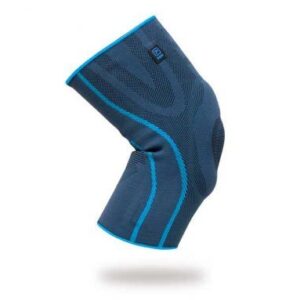Knee sprain
A knee sprain occurs when the ligaments that stabilise the knee joint are stretched or torn due to sudden movements.
Most common knee pathologies
Symptoms
Acute pain may occur during the initial trauma. Oedema (swelling) may occur due to the inflammatory response, as well as instability, with a feeling of weakness or inability to bear weight. Sprains can be graded: Grade I - Mild stretching of the ligaments; Grade II - Partial rupture of the ligaments; Grade III - Complete rupture of the ligaments.
Risk Factors
Contact sports or sports involving rapid changes of direction; Weak muscles around the knee can increase the risk; Previous injuries can predispose to sprains.
Protective Factors
Exercises to strengthen the quadriceps and hamstrings; Correct execution of movements and physical activities; Use of protective equipment in risky sports.
Treatment
R.I.C.E.: Rest, Ice, Compression and Elevation for initial symptom control. Exercises for muscle strengthening, stretching and improving stability; In severe cases, immobilisation using a splint or orthosis may be necessary; In cases of severe ruptures or associated injuries, surgery may be indicated.
Information: All the information contained here is merely a summary for a general understanding of the pathologies, highlighting their definition, symptoms, risk factors, protective measures and treatment options.
Consulting a specialised health professional is essential for an accurate diagnosis and an effective treatment plan.
Support and protection for knee sprains
Discover all the orthoses for knee sprains
-
Seleccione Opções This product has multiple variants. The options may be chosen on the product page
-
Seleccione Opções This product has multiple variants. The options may be chosen on the product page
Genumedi Simple Elastic Knee Brace for Centring the Rotula
40,70 €Avaliado 0 out of 5( 0 comentários ) -
Seleccione Opções This product has multiple variants. The options may be chosen on the product page
Genumedi PA Elasticated Knee Support for Goose Foot Tendonitis Pain Relief
61,05 €Avaliado 0 out of 5( 0 comentários ) -
Seleccione Opções This product has multiple variants. The options may be chosen on the product page
-
Seleccione Opções This product has multiple variants. The options may be chosen on the product page
Genumedi PSS Elastic Knee Brace for Centralisation and Rotator Support
67,90 €Avaliado 0 out of 5( 0 comentários ) -
Seleccione Opções This product has multiple variants. The options may be chosen on the product page
Genumedi PT Elasticated Knee Brace for Traction of the Rotator Cuff
57,00 €Avaliado 0 out of 5( 0 comentários ) -
Seleccione Opções This product has multiple variants. The options may be chosen on the product page
-
Seleccione Opções This product has multiple variants. The options may be chosen on the product page
-
Seleccione Opções This product has multiple variants. The options may be chosen on the product page
-
Seleccione Opções This product has multiple variants. The options may be chosen on the product page
-
Seleccione Opções This product has multiple variants. The options may be chosen on the product page
-
Seleccione Opções This product has multiple variants. The options may be chosen on the product page
Protect.Co Knee Brace with Flexion and Extension Adjustment
258,00 €Avaliado 0 out of 5( 0 comentários )















